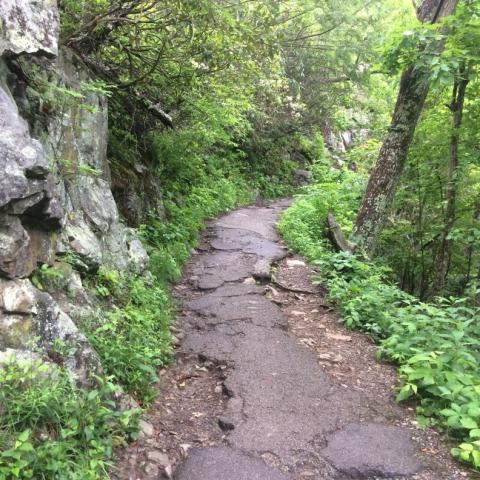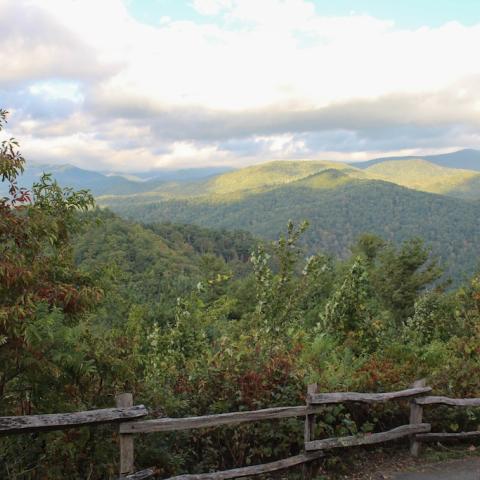
Clingmans Dome, which is topped by a popular observation tower, would be renamed under an application approved by the Eastern Band of Cherokee Indians/NPS file
Clingmans Dome, the highest point in Great Smoky Mountains National Park, could undergoe a name change back to the name the Cherokee used for time immemorial. The Eastern Band of Cherokee Indians Tribal Council last week approved a resolution to forward an application to the federal government asking that the 6,643-foot high summit be renamed Kuwohi, a Cherokee word that means "Mulberry Place."
County commissions in both Tennessee and North Carolina reportedly have voted in favor of the name change. Whites in 1859 named the mountain for Thomas Lanier Clingman, a pro-slavery Confederate general and U.S. Senator from North Carolina.
If the application is approved, it would be just the latest name change in the National Park System.
Back in 2022 the National Park Service announced that Mount Doane in Yellowstone National Park had been renamed First Peoples Mountain.
First Peoples Mountain is a 10,551-foot peak within Yellowstone east of Yellowstone Lake in the southeastern portion of the park. The peak was previously named after Gustavus Doane, a key member of the Washburn-Langford-Doane expedition in 1870 prior to Yellowstone becoming America’s first national park. Research has shown that earlier that same year (1870), Doane was involved in an attack, in response to the alleged murder of a white fur trader, on a band of Piegan Blackfeet. During what is now known as the Marias Massacre, at least 173 Native Americans were killed, including many women, elderly tribal members and children suffering from smallpox.
Then-Interior Secretary Sally Jewell in August 2015 directed that Mount McKinley in Denali National Park be officially renamed "Denali," the traditional Koyukon Athabascan name of the peak. Secretary Jewell gained the support of President Obama to issue a Secretarial Order that officially changed the name.
Since 1987 and until August 2015 the official name of the mountain in federal publications had been Mount McKinley. The mountain retained the federally authorized name Mount McKinley, even as the name of the national park was changed in 1980 from Mount McKinley National Park into the new (and larger) area named Denali National Park and Preserve under the Alaska National Interest Lands Conservation Act.
The mountain's McKinley name dates to 1896, when a prospector emerged from exploring the mountains of central Alaska and received news that William McKinley had been nominated as a candidate for president of the United States. In a show of support, the prospector declared the tallest peak of the Alaska Range as Mount McKinley — and the name stuck. For centuries, the mountain that rises more than 20,000 feet above sea level, the tallest on the North American continent, had been known by as Denali.



 Support Essential Coverage of Essential Places
Support Essential Coverage of Essential Places







Comments
erasing history. Again. As far as I am concerned this is an abomination of the NPS procedures. The tribal members can make a public comment about such proposals just like any other American citizen. The idea that they get to come up with new names for historical landmarks in America is a joke. This is yet another insider decision by Chuck Sams and Deb Haaland. They have made a mockery of the NPS. And people though Zinke was bad
Why not change the entire park name to some Cherokee name instead of dealing with actual issues to improve the lives of people?
Why not change the name of the state for that matter?
Enough of this division. Enough.
There was never "a" name for Clingman's Dome, so "Mulberry Place" is as inaccurate as any other possible name out there.
For example, renaming Indian Gardens in GC has done NOTHING to resolve any conflicts anywhere. Most likely, it's simple created more confusion for those hiking down there or passing through. And in GC, confusion can kill. All for what purpose?
If we're "offended" by naming the mountain after a confederate rebel , then let's abolish the five "civilized" tribes of OK who supported the confederacy and practiced slavery of black people in a way that would make Jeff Davis blush. And of course, the discrimination fo these tribes in OK continues today as the tribes exclude any descendant of their slaves from tribal membership. Do a bit of research on a guy named Joseph Vann. Why is "offense" a one-way street...a one way street to nowhere?
These are NAMES, just NAMES, and nothing else. They cannot offend, hurt, destroy, traumatize, or anything else. THEY ARE NAMES!
My god, we're consuming ourselves.
Enough.
we Are supposed to learn from the past; but erasing the past is a good way to repeat things in the past.
If you had bothered to read, you'd see that the name is being changed back to what it was called historically. If anything, the people who changed the name in 1859 were erasing history and now we are restoring it.
He who control the past control the future. He who controls the future controls the past.
Thank you!! I don't think any of the previous commenters actually read the article.
My understanding is Clingman surveyed most of the peaks in this area. No mention of that in this article.